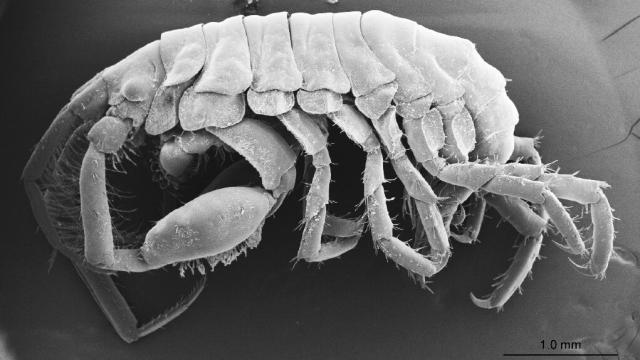Japanese scientists have discovered a new species of crustacean in the gills of a shark, according to a recent paper.
Amphipods make up an order of nearly 10,000 species that live in aquatic habitats. They’re mostly scavengers, feeding on decomposing skin, poop, and other leftovers. Some are associated with animals like sea turtles and cetaceans. This is the first one found on a whale shark, the largest fish species in the ocean. I cannot imagine that this relationship feels very good for the shark.
Scientists sampled the whale shark’s gills with a suction pump while scuba diving in an underwater fish preserve off of Okinawa in 2017. They examined and measured the specimens under a microscope and sequenced the crustacean’s DNA, revealing that they’d discovered a whole new species of amphipod. They named it Podocerus jinbe; Podocerus from the already-existing genus, and jinbe, from the Japanese word for whale shark “Jinbē-zame.”
These half centimetre-sized spiny creatures seem to swarm their host; the researchers found 357 males and 291 females on the animal. The amphipods don’t feed on the shark directly, the researchers wrote, but it’s possible that they were feeding on detritis entering the shark’s gills. Indeed, the creatures’ presence seemed to be making it harder for the shark to breathe, the researchers wrote in the paper published in Species Diversity. The whale shark died from unknown causes three months after the researchers found it.
Not only to these amphipods swarm sharks, but apparently similar species will swarm other creatures that enter their space, like human scuba divers.
*Shudders*
Tammy Horton, a researcher not involved with the study who studies amphipods in the National Oceanography Centre in the United Kingdom, told Gizmodo it was definitely an interesting find. But whether the species is actually associated with whale sharks or whether it was merely a local species opportunistically feeding remains to be seen.
“It highlights just how little we know about Amphipods and how there are so many new species to describe,” she wrote in an email.
Amphipods represent some of life’s extremes and have even been found in the Mariana Trench’s Challenger Deep. They serve an important role in the food chain recycling nutrients from trash and refuse. Whale sharks, meanwhile, are one of the largest creatures in the ocean—and by far the largest non-mammal—but are endangered and threatened by fisheries as well as vessel strikes. These animals, too, are mysterious to humans. None have been observed giving birth, for example.
And whether or not the amphipods are actually associated with the whale shark, the find represents the union of large and small in the ocean, as well as the ubiquity of these strange, tiny creatures.
